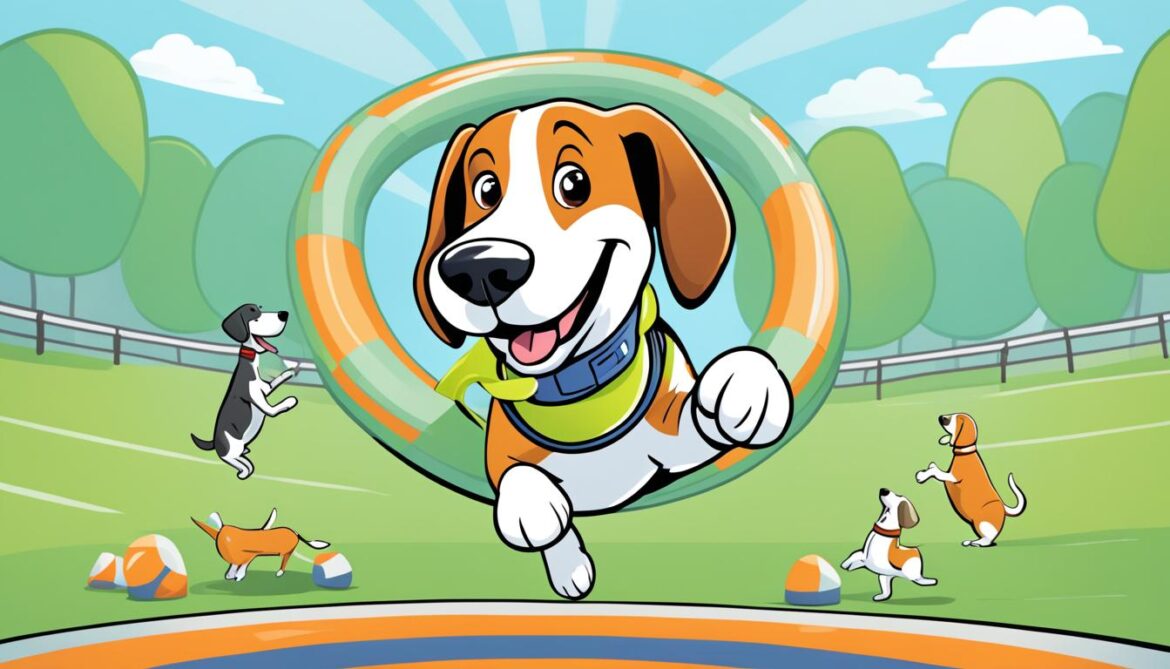Imagine the joy of coming home to a well-behaved, obedient, and happy beagle. A furry companion who listens to your commands, behaves appropriately in any situation, and brings endless love and laughter to your life. This dream can become a reality when you master the art of beagle training.
Beagles are known for their charming personalities, but they can also be stubborn and independent. As a beagle owner, you may have experienced the frustration of dealing with their unique behavioral quirks, from excessive barking to irresistible chasing instincts.
But don’t lose hope. With the right training techniques, you can effectively modify your beagle’s behavior, strengthen your bond, and create a harmonious relationship that lasts a lifetime.
Key Takeaways:
- Mastering beagle training techniques can bring joy and obedience to your furry friend.
- Beagles have charming personalities but can be stubborn and independent.
- With the right training techniques, you can modify your beagle’s behavior and strengthen your bond.
- Understanding the unique traits of beagles is crucial for effective training.
- Obedience training and positive reinforcement are essential for a well-behaved beagle.
Understanding Beagle Behavior
Before embarking on the journey of beagle training, it’s essential to have a solid grasp of their unique behavioral traits. Understanding their natural instincts and tendencies will enable you to effectively modify their behavior and foster a harmonious relationship with your beloved pet. Here are some valuable insights and tips to help you manage common challenges that beagle owners often encounter.
1. Scent-Driven Nature
Beagles have an exceptional sense of smell, driven by their instinctive hunting abilities. This means they can easily get distracted by scents, making them prone to wandering off or becoming unresponsive during training sessions. To tackle this challenge, it’s crucial to establish a strong foundation of focus and attention. Start training in a controlled environment with minimal distractions, gradually increasing the difficulty level as your beagle becomes more responsive.
2. High Energy Levels
Beagles are known for their boundless energy. It’s vital to provide them with regular exercise and mental stimulation to prevent behavioral issues arising from pent-up energy. Incorporate daily walks, playtime, and interactive toys into their routine to keep them physically and mentally engaged. A tired beagle is more likely to be attentive and receptive to training.
3. Social Nature
Beagles are friendly and sociable by nature. They thrive on companionship and may exhibit separation anxiety if left alone for long periods. When training your beagle, create a positive and supportive atmosphere, providing plenty of love, attention, and reassurance. Socialize them from an early age by exposing them to different environments, people, and animals. This will help develop their confidence and prevent behavioral issues.
4. Prey Drive
Beagles possess a strong prey drive, a characteristic stemming from their hunting background. They may be easily distracted by smaller animals, constantly sniffing, or attempting to chase them. To manage this behavior, it’s important to reinforce obedience training, especially the “leave it” and “recall” commands. Training sessions that simulate real-life scenarios can help redirect their attention and reinforce appropriate behavior.
Remember, each beagle is unique, and their individual personalities will influence their response to training. Patience, consistency, and positive reinforcement are key to modifying their behavior effectively.
By gaining a deeper understanding of your beagle’s behavioral traits, you can structure your training sessions to cater to their specific needs. With the right approach and techniques, you’ll set the foundation for a well-behaved and happily trained beagle companion.
| Common Beagle Behavior Challenges | Solutions |
|---|---|
| Excessive barking | Teach the “quiet” command, redirect their focus, and provide mental stimulation. |
| Digging | Create designated dig areas and provide suitable alternatives such as digging toys. |
| Chewing | Offer appropriate chew toys and discourage destructive chewing by redirecting and providing positive reinforcement. |
| Pulling on the leash | Use positive reinforcement to teach loose leash walking and provide regular leash training sessions. |
Managing and modifying your beagle’s behavior requires patience, consistency, and a deep understanding of their unique characteristics. By implementing effective training techniques and meeting their specific needs, you’ll develop a strong bond and a well-behaved, happy beagle companion.
Obedience Training for Beagles
Obedience training is an essential part of ensuring that your beagle is well-behaved and follows basic commands. By establishing boundaries and teaching your beagle essential commands, you can create a structured environment that promotes positive behavior and strengthens the bond between you and your furry friend.
Proven Techniques for Effective Beagle Training
When it comes to beagle obedience training, it’s important to use methods that are both effective and humane. Here are some proven techniques to help you train your beagle:
- Start with the basics: Begin by teaching your beagle commands like sit, stay, come, and down. These commands lay the foundation for more advanced training.
- Positive reinforcement: Reward your beagle with praise, treats, or playtime whenever they exhibit the desired behavior. This positive reinforcement helps them understand what is expected of them.
- Consistency is key: Be consistent in your training approach and use the same commands and hand signals every time. This consistency helps your beagle understand and respond to your cues effectively.
- Patience and persistence: Remember that training takes time and patience. Don’t get discouraged if your beagle doesn’t grasp a command immediately. Keep practicing and reinforcing the desired behavior.
By implementing these techniques, you can effectively train your beagle to become a well-mannered and obedient companion.
“Good habits formed at youth make all the difference.” – Aristotle
Addressing Disobedient Tendencies
While beagles are generally eager to please, they may display disobedient tendencies from time to time. Here are some strategies to address these behaviors:
- Redirect their attention: If your beagle becomes distracted or ignores a command, redirect their attention using a toy or treat to regain their focus.
- Ignore unwanted behavior: If your beagle exhibits unwanted behavior, like jumping or barking excessively, ignore it. By withholding attention, you discourage these behaviors.
- Seek professional help: If your beagle’s disobedience persists or escalates, consider seeking assistance from a professional dog trainer. They can provide specialized guidance and support to address specific behavioral issues.
Remember to approach training with a positive attitude and to celebrate your beagle’s progress along the way. With patience, consistency, and effective training techniques, you can mold your beagle into a well-behaved and obedient companion.

Professional Beagle Training Services
If you’re looking to provide your beagle with the best possible training experience, professional beagle training services can be a game-changer. These services offer expert guidance and tailored programs designed to address your beagle’s specific needs.
Benefits of Professional Beagle Training Services
Enrolling your beagle in professional training programs brings a host of benefits. Trained professionals have extensive knowledge and experience in handling beagles, allowing them to accelerate the training process and achieve faster results.
“Professional beagle training services provide a structured environment where your beagle can learn and grow under the guidance of skilled trainers.” – [Trainer’s Name], Professional Beagle Trainer
Furthermore, professional training programs offer a range of services to meet your beagle’s individual requirements. These services may include obedience training, behavior modification, socialization, and more.
Types of Professional Beagle Training Programs
Professional beagle training services typically offer various programs to cater to different training needs. Some common types of training programs include:
- Obedience Training: Helps your beagle learn basic commands and better control their behavior.
- Behavior Modification: Addresses specific behavioral issues such as leash pulling, barking, or separation anxiety.
- Socialization Programs: Focuses on helping your beagle interact positively with other dogs and people.
- Advanced Training: Provides advanced training techniques for beagles with specific goals, such as therapy work or competitive obedience.
Each program is tailored to meet your beagle’s unique needs, ensuring a personalized and effective training experience.
Image: A beagle training session with a professional trainer. (Image source: seowriting.ai)
Find the Right Fit for Your Beagle
When choosing a professional beagle training service, it’s important to find the right fit for your furry companion. Consider the following factors:
| Factor | Considerations |
|---|---|
| Experience and Credentials | Ensure the trainers have a solid background in beagle training and are certified professionals. |
| Training Methods | Research the training methodologies used to ensure they align with your training philosophy. |
| Facilities and Environment | Visit the training facility to ensure a clean, safe, and conducive learning environment for your beagle. |
| Client Testimonials | Read reviews and testimonials from previous clients to gauge the effectiveness and satisfaction of the training programs. |
By carefully considering these factors, you can find a professional beagle training service that meets your expectations and helps your beagle unlock their full potential.
Tips for Beagle Training at Home
Training your beagle at home can be a rewarding experience. By implementing effective beagle training methods and following these beagle training tips, you can create a positive learning environment for your furry friend. Here are some practical tips and techniques for successful at-home training sessions:
- Establish a Consistent Routine: Consistency is key when it comes to beagle training. Set a regular schedule for potty breaks, meal times, and training sessions. This helps your beagle understand expectations and promotes faster learning.
- Use Positive Reinforcement: Beagles respond well to positive reinforcement. Reward good behavior with treats, praise, and affection. This encourages your beagle to repeat desirable actions and builds a strong bond between you and your furry companion.
- Start with Basic Commands: Begin training with simple commands like “sit,” “stay,” and “come.” Use clear, consistent cues and be patient with your beagle as they learn. Remember to reward successful attempts and gradually increase the difficulty level.
- Address Specific Behavioral Issues: If your beagle exhibits specific behavioral issues like excessive barking or digging, address them during training sessions. Identify the triggers and use positive reinforcement techniques to redirect their behavior. Seek professional guidance if needed.
Remember, beagle training takes time and patience. Each beagle is unique, so tailor your training approach to suit their personality and needs. By using effective beagle training methods and providing consistent guidance, you can help your furry friend become a well-behaved and happy companion.
“Training your beagle at home can be a rewarding experience. By implementing effective beagle training methods and following these beagle training tips, you can create a positive learning environment for your furry friend.”
Beagle Training Classes: Choosing the Right Fit
Beagle training classes provide a structured environment for socialization and learning, setting the foundation for a well-behaved and happy beagle. Enrolling your furry companion in a training class can offer numerous benefits, such as:
- Learning from professional trainers who specialize in beagle behavior and training techniques
- Gaining access to a supportive community of fellow beagle owners, offering guidance and encouragement
- Improving your beagle’s obedience, responsiveness, and overall behavior
- Providing focused training sessions with exercises designed to address common beagle challenges
When choosing the right beagle training class, consider the following factors:
- Class Format: Beagle training classes can vary in format, such as group classes, private sessions, or a combination of both. Group classes allow beagles to interact with other dogs and work on socialization skills, while private sessions offer one-on-one attention from the trainer.
- Trainer Qualifications: Look for trainers who have experience working with beagles specifically and hold certifications from reputable organizations. A qualified trainer will have expertise in beagle behavior and training methods.
- Training Philosophy: Consider the training methods and philosophy used in the class. Positive reinforcement techniques, such as rewards and praise, are generally effective and humane. Avoid classes that rely on fear-based or punishment-based methods.
- Location and Schedule: Choose a training class that is conveniently located and fits well with your schedule. Regular attendance and consistency are crucial for effective training.
Remember, each beagle is unique, so it’s essential to find a training class that suits your beagle’s individual needs and temperament. Take the time to research and visit different classes to evaluate the environment, trainer’s approach, and overall program. Your beagle’s well-being and development depend on choosing the right fit for their training journey.
Comparison of Beagle Training Class Formats
| Class Format | Description | Advantages |
|---|---|---|
| Group Classes | Multiple beagles and owners attend classes together, allowing for socialization and learning in a group setting. |
|
| Private Sessions | One-on-one training sessions with a trainer, focusing on individual beagle’s needs and addressing specific behavior challenges. |
|
| Combination Classes | A mix of group classes and private sessions, providing the benefits of both formats. |
|
Overcoming Common Beagle Training Challenges
Training your beagle can be an incredibly rewarding experience, but it’s not without its challenges. In this section, we will address some of the most common obstacles that beagle owners face during the training process and provide effective solutions to overcome them. By understanding these challenges and utilizing the right techniques, you can ensure a successful training journey with your beloved furry friend.
1. Handling Stubbornness
Beagles are known for their stubborn nature, which can make training them a bit more challenging. However, with patience and consistency, you can overcome their stubborn tendencies. It’s important to establish clear boundaries and use positive reinforcement techniques to motivate your beagle. Rewarding good behavior and redirecting their attention when they’re being stubborn can help encourage them to follow your commands.
2. Addressing Separation Anxiety
Many beagles experience separation anxiety, which can manifest as destructive behaviors or excessive barking when left alone. To address this issue, it’s essential to gradually desensitize your beagle to being alone. Start by leaving them alone for short periods and gradually increase the duration over time. Providing them with interactive toys, a comfortable space, and engaging in pre-departure routines can also help alleviate separation anxiety.
3. Managing Excessive Barking
Beagles have a natural instinct to bark, and while it’s a part of their breed’s characteristics, excessive barking can be problematic. To manage excessive barking, first, determine the underlying cause. It could be due to boredom, fear, attention-seeking, or something else. Once you identify the cause, you can address it with appropriate training methods. For example, if your beagle barks when bored, providing mental and physical stimulation through interactive toys and regular exercise can help reduce their barking.
4. Dealing with Other Behavioral Issues
Beagles may also display other behavioral issues, such as digging, chewing, or jumping on people. These behaviors can be managed through consistent training techniques. For instance, redirecting their chewing behavior to appropriate toys and providing them with plenty of exercise can help alleviate destructive chewing tendencies. Training them to greet people calmly and reinforcing desired behaviors can also address jumping issues.
“Consistency and positive reinforcement are key when training a beagle. With the right approach, you can overcome any training challenge and create a well-behaved and happy companion.” – Dog Training Expert
By implementing these tips and techniques, you can overcome common training challenges and establish a strong bond with your beagle. Remember, patience and consistency are essential, and always celebrate small victories along the way. With effective training methods and a little bit of love, your beagle can become a well-behaved and obedient member of your family.

| Challenge | Solution |
|---|---|
| Stubbornness | Establish clear boundaries, use positive reinforcement, and redirect attention |
| Separation Anxiety | Gradually desensitize your beagle to being alone, provide interactive toys, and engage in pre-departure routines |
| Excessive Barking | Determine the underlying cause, provide mental and physical stimulation, and address the issue through training |
| Other Behavioral Issues | Redirect unwanted behaviors, provide appropriate toys and exercise, and reinforce desired behaviors |
Conclusion
In conclusion, mastering beagle training requires patience, consistency, and an understanding of their unique behaviors. By implementing effective techniques and approaches, you can shape your beagle’s behavior and create a harmonious bond with your furry friend.
Begin by understanding the instinctual traits and tendencies of beagles, as this knowledge will help you modify their behavior more effectively. With this understanding, you can start obedience training, teaching your beagle essential commands and reinforcing positive behavior.
Consider professional beagle training services if you need expert guidance or want to fast-track your beagle’s training journey. These professionals offer specialized programs designed to address specific behavioral issues and create well-rounded dogs.
For at-home training, establish a consistent routine, use positive reinforcement techniques, and address specific challenges your beagle may face. Training at home provides a rewarding experience and strengthens the relationship between you and your dog.
Remember, beagle training is a continuous process that requires patience, consistency, and adaptability. Celebrate progress, stay positive, and never hesitate to seek help when needed. With the right techniques and dedication, you can successfully train your beagle and build a lifelong bond based on trust and respect.
